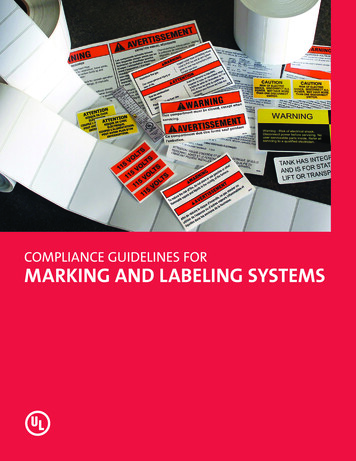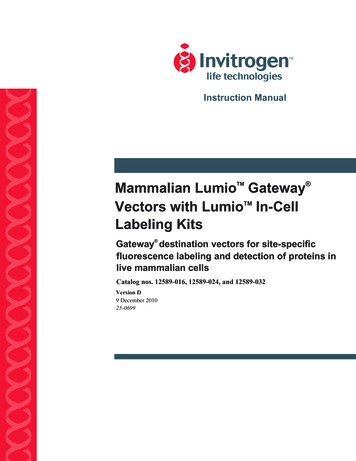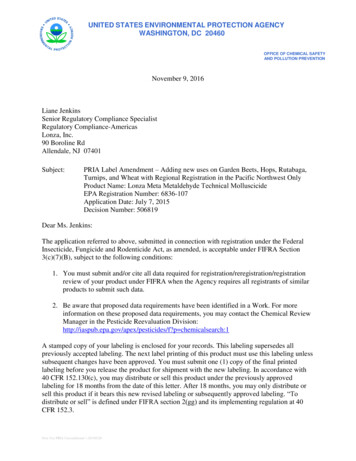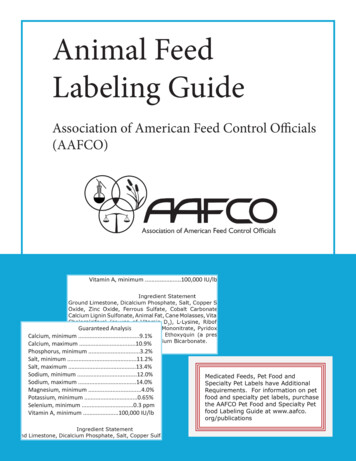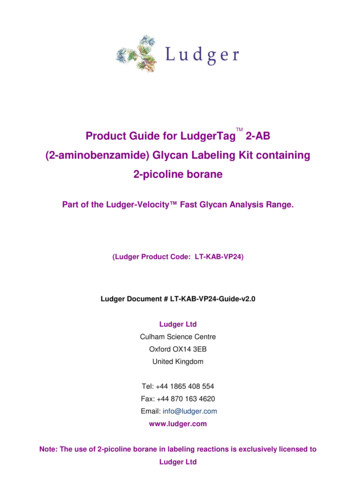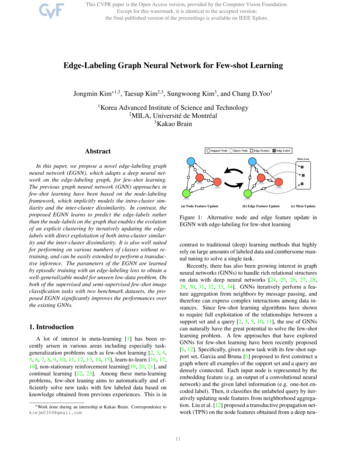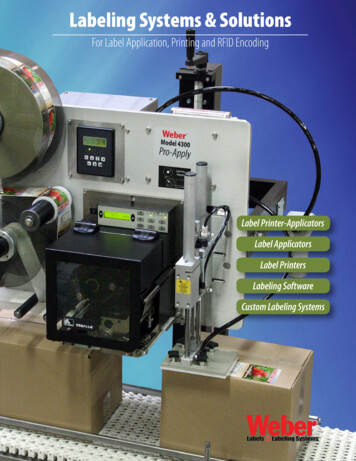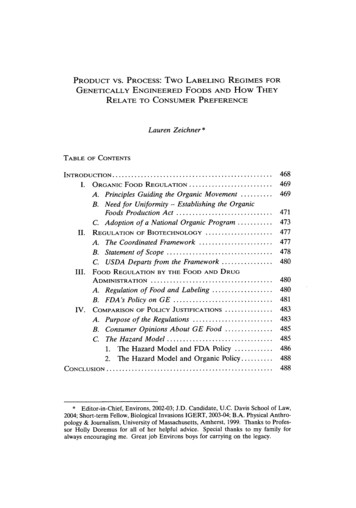
Transcription
PRODUCT VS. PROCESS:TwoLABELING REGIMES FORGENETICALLY ENGINEERED FOODS ANDHowTHEYRELATE TO CONSUMER PREFERENCELauren Zeichner *TABLE OF CONTENTSINTRODUCTION .I.II.III.ORGANIC FOOD REGULATION .469A. Principles Guiding the Organic Movement .B. Need for Uniformity - Establishing the OrganicFoods Production Act .C. Adoption of a National Organic Program .469REGULATION OF BIOTECHNOLOGY .477A. The Coordinated Framework .B. Statement of Scope .C. USDA Departs from the Framework .477478480FOOD REGULATION BY THE FOOD AND DRUGADMINISTRATION .A. Regulation of Food and Labeling .B. FDA's Policy on GE .IV.468COMPARISON OF POLICY JUSTIFICATIONS .A. Purpose of the Regulations .B. Consumer Opinions About GE Food .C. The Hazard Model .1. The Hazard Model and FDA Policy .2.The Hazard Model and Organic Policy .CONCLUSION .471473480480481483483485485486488488* Editor-in-Chief, Environs, 2002-03; J.D. Candidate, U.C. Davis School of Law,2004; Short-term Fellow, Biological Invasions IGERT, 2003-04; B.A. Physical Anthropology & Journalism, University of Massachusetts, Amherst, 1999. Thanks to Professor Holly Doremus for all of her helpful advice. Special thanks to my family foralways encouraging me. Great job Environs boys for carrying on the legacy.
Environs[Vol. 27:2INTRODUCTIONThe labeling of food in the United States serves two important functions. First, labels provide consumers with information necessary for theprotection of public health, safety and welfare. Second, labels promoteiair trade practices in food marketing.' Both functions serve consumers indifferent ways so agencies that develop labeling regimes use a range ofmethods to assure their labels are effective. Agencies do not always consider consumer opinion when setting labeling policies that can have anegative effect on consumer confidence. What happens when an agencybelieves that a labeling policy is looking out for consumer welfare butconsumer confidence itself remains low?This paper will examine two labeling regimes and the methods usedto develop accurate labels for foods containing the products of geneticengineering (GE). Under certain circumstances, these policies can satisfy their respective goals, though each handle consumer preference andexpectation very differently. While one relies on consumer impressions,the other focuses on scientific risk-based decision-making. The result ofapplying these two divergent policies is that GE foods are treated verydifferently depending on which federal agency is applying theirmethodology.The United States has one marketing regime enforced by the UnitedStates Department of Agriculture (USDA) who, after considering consumer expectation, determined that genetic engineering is a process incompatible with the principles of the National Organic Program (NOP).Therefore, no food containing GE products can be labeled organic underthe USDA approach. The United States also recognizes the labeling authority of the Federal Drug Administration (FDA), which refuses to label GE products because they are not materially different from the foodin its natural state. This determination was based on scientific principlesmeant to protect consumer health without being misleading.This paper will look behind this process/product dichotomy and discuss the reasons each agency began to look at the process of genetic engineering differently than the product. The paper then examines consumerconcerns about GE foods to determine whether people are generallyworried about the risks posed by the food itself or the processes utilizedto make the food. After showing that consumer concerns do not fitneatly into one or the other of these categories, the paper concludes byasking how we might be able to encourage greater confidence in consumers about foods that now carry the stigma of risk but are deemed safe byscientific standards.1 Kyle W. Lathrop, Pre-empting Apples with Oranges: Federal Regulation of Organic Food Labeling, 16 J. CORP. L. 885, 885-86 (1992).
Spring 2004]I.Product vs. ProcessORGANIC FOOD REGULATIONA.Principles Guiding the Organic MovementLord Walter Northbourne first coined the term "organic farming" in1940 as a chapter heading in his book Look to the Land Little did heknow how greatly these two words would contrast the current scientificprogress occurring in agriculture at the time. The 20th century broughtadvances such as the regulation of plant growth by specific chemical substances and the use of poisons to control pests.' For example, herbicides- chemicals that kill undesired weeds while leaving crops unscathed were developed, thus eliminating the need to for manual weed control.Discoveries in chemical science also gave farmers more control over thegrowing cycles of their plants, which provided great economic benefits.'Because these technologies were such an advantage to the farmer, chemical use quickly became widespread. A 1947 horticulture book expressesthat, "A chemical revolution is sweeping through the agricultural world.It is unrivalled by any of the previous great advances in agriculture and,perhaps, by most advances in the biological field." 6In 1962, Rachel Carson published Silent Spring, which exposed thedangers of pesticides to human health and the environment In doing so,she explained the interrelationship of living organisms. She helped people understand that humans are not separate from nature and that whatis done to one species will affect all others in the environment, includinghumans. This realization served as a catalyst for the modern organic agriculture movement by creating broad public awareness of the need to beconscious and careful of our agricultural practices.' In this way, organicagriculture has become a philosophical reaction to technology, striving to10eliminate all "chemicals" except those that are "natural" or "organic.This broad concern about on environmental protection permeatesthe modern organic community. According to one marketing survey,consumers of organic food are 31% more concerned about pollution andthe environment than the general population.1 Studies also show that2RONALDF.KORCAK, HISTORY OF THE ORGANIC MOVEMENT(1991)availableat 31/r 31-2.html (last visited May1, 2004).3 Jules Janick, Purdue University Lecture 31 History of Horticulture(2002), available at 3l/lec3l.html.4Id.5 Id.6 Id., quoting AVERY AND JOHNSON, HORMONES AND HORTICULTURE (1947).7 See generally RACHEL CARSON, SILENT SPRING (1962).See9 Id.8PAUL BROOKS, HOUSE OF LIFE: RACHEL CARSON AT WORK(1972).Jules Janick supra note 3.11 Consumer Profile Facts, Organic Trade Association, at http://www.ota.com/or10ganic/mt/consumer.html (last visited May 20, 2003).
[Vol. 27:2Environsorganic consumers are generally as concerned about environmental protection as they are about their own personal safety. 2 Organic agriculturehas responded to these concerns by producing food in ways that are consistent with these ideals.These ideals are nicely articulated by The International Federationof Organic Agriculture Movements (IFOAM), the self-proclaimed1 3"worldwide umbrella organization of the Organic Movement.IFOAM's goal is to provide authoritative information about organic agriculture and to promote its worldwide application.14 Additionally, it servesits member organizations by providing representation at internationalpolicy making forums. 5 IFOAM defines organic agriculture to be "allagricultural systems that promote the environmentally, socially and economically sound production of food . By respecting the natural capacity of plants, animals and the landscape, it aims to optimize quality in allaspects of agriculture and the environment."' 6At the international level, both the public and private sectors havecodified these principles to help guide governments and private certification bodies in setting standards for specific organic programs. The Foodand Agriculture Organization (FAO) of the United Nations (UN) created the Codex Alimentarius for the public sector and IFOAM established the International Basic Standards for Organic Production andProcessing for the private sector. 7 Governments can use these standardsto develop national organic agriculture programs, which can be modifiedto respond to a specific country's needs."The standards set forth the idea that organic farming systems shouldrely on ecologically based production methods such as cultural and biological pest management. They virtually exclude the use of syntheticchemicals in crop production and prohibit the use of antibiotics and hormones in livestock production. 9 Under organic farming systems, the fundamental components and natural processes of ecosystems - such as soil12CATHERINEEMERGES IN THER. GREENE, U.S.DEPT. OF AGRIC.,1990s, ERS AIB No. 770 at 3 (2001).U.S.ORGANIC1314About IFOAM, at http://www.ifoam.org (last visited April 21, 2004).Id.1516Id.Id.FARMINGSee generally CODEX ALIMENTARIUS COMMISSION GUIDELINES FOR PRODUCTION, FAO/WHO, PROCESSING, LABELING AND MARKETING OF ORGANICALLY PRODUCED FOODS, July 2001, available at f (last visited Feb. 25, 2004). See generally Basic Standards for Organic Productionand Processing, IFOAM General Assembly (Sept. 2000), available at http://www.ifoam.org/standard/indexneu.html (last visited Feb. 25, 2004).18 Frequently Asked Questions- "What is behind an organic label?" Organic Agriculture at FAO, at http://www.fao.org/organicag/framll-e.htm (last visited Feb. 25,2004).19 GREENE, supra note 12, at 1.17
Spring 2004]Product vs. Processorganism activities, nutrient cycling, and species distribution and competition - are incorporated directly and indirectly as crop managementtools." Consumers who buy organic foods do so because foods grown inthis way provide them with perceived benefits over foods grown withchemicals."Need for Uniformity - Establishing the Organic Foods ProductionActB.What began as a grass roots effort by organic farmers and homegardeners has matured into a thriving industry.' Organic farming became one of the fastest growing segments of U.S. agriculture during the1990's. Between 1992 and 1997 certified organic cropland more thandoubled' and sales of organics increased more than 20% annually from1990-2000. Industry estimates of U.S. organic sales from 1990 through1996 show sales growing 20-25% annually and reaching 3.3 billion in1996.' There are estimates that organic food sales were 7.8 billion in2000, a 20-percent increase over 1999 sales.26The growing popularity of organic food brought with it a need for aneffective labeling system to distinguish organic from non-organic foods.Before 1990, private organizations and state agencies had the authorityto certify organic practices in their jurisdiction. Not surprisingly, therewas no uniformity in standards and therefore no guarantee that "organic" meant the same thing from state to state.27 By 1990, twenty-twostates had adopted organic food statutes that all varied in one way oranother.282021Id. at 1.Consumer Profile Facts, Organic Trade Association, at http://www.ota.com/organic/mt/consumer.html (last visited May 20, 2003). "The 'Organic Lifestyle ShopperStudy 2000,' conducted by the Hartman Group market research firm, reports that thetop five motivators for organic food and beverage purchases are: health/nutrition,66% (most organic users consider that organic products contribute to their overallhealth, rather than associating organic products with any specific health benefit);taste, 38%; food safety, 30% (organic consumers are concerned about food safety);environment, 26%; and availability, 16%.22 Cindy Joffe Hyman, Comment: Food For Thought: Defending the OrganicFoods Production Act of 1990 Against Claims of Protectionism, 14 EMORY INT'L L.REV. 1719 (2000).23 GREENE, supra note 12, at 6.24 Id. at 2.25 Organic Farming and Marketing: Questions and Answers, U.S. DEr.OFAGRIC./ERS Briefing Room, at /orgqa5.htm (last updated June 24, 2003).26 Id.27 Kenneth C. Amaditz, The Organic Foods Production Act of 1990 and its Impending Regulations: A Big Zero for Organic Food? 52 FOOD DRUG L.J. 537, 539(1997); S. REP. No. 101-357(1990), reprinted in U.S.C.C.A.N. 4942, 4944.28 S. REP. No. 101-357(1990), reprinted in U.S.C.C.A.N. 4942, 4943.
Environs[Vol. 27:2Farmers and processors have no choice but to produce andlabel their products according to conflicting standards. As aresult, consumers are left to decipher a confusing array of private and State labels. Even the most sophisticated organicconsumer finds it difficult to know, with certainty, what theterm "organic" really means. For example, currentlyprocessed food may be labeled "organic" regardless ofwhether it contains 100 or 20 percent organically growningredients.29This confusing web of regulations had the potential to hinder thegrowing market for organic goods. Production methods were very important to organic consumers and because there was no regulatory consensus on the issue producers did not know what methods to use. It becameclear that uniform production standards were needed to ensure that theend product was consistent with consumer expectations and labeling representations. Reliability in the form of a national standard for organicfoods could encourage the growth of this burgeoning market, so the National Association of State Departments of Agriculture, American FarmBureau Federation, several major organic industry trade associations, aswell as consumer interests rallied Congress for a national organic labeling program."To address this problem, Congress adopted the Organic Foods Production Act of 1990 (OFPA).31 The OFPA had three main goals: (1) establish national standards governing the marketing of certain agriculturalproducts as organically produced; (2) assure consumers that organicallyproduced products meet a consistent standard; and (3) facilitate interstate commerce in fresh and processed food that is organically produced. " In the OFPA, Congress broadly defined "organically produced"as "an agricultural product that is produced and handled in accordancewith this chapter."" Congress was reluctant to specifically define "organic food" in the Act but their goal for the "organically produced" labelis clear from the legislative history.Organic food is food produced using sustainable productionmethods that rely primarily on natural materials. The "organically produced" label authorized under this bill thereforepertains to the production methods used to produce the foodrather than to the content of the food.3The task of defining these production methods became one of themost difficult and controversial endeavors that grew out of the OFPA.29 Id.30 S.REP. No. 101-357(1990), reprinted in U.S.C.C.A.N.31 Organic Foods Production Act, 7 U.S.C. §§ 6501-652232 7 U.S.C. §6501 (2004).33 Id. at §6502 (14).34 S. REP. No. 101-357(1990), reprinted in U.S.C.C.A.N.at 4942, 4944.(2004).at 4942, 4944.
Spring 2004]Product vs. ProcessThe Act gave the United States Department of Agriculture the responsibility for achieving this goal by establishing an organic certification program." The OFPA contained three specific guidelines to guide theUSDA. First, organic agricultural products had to be produced withoutthe use of synthetic chemicals. Second, products could not be grown onland to which any prohibited substances had been applied during thethree years immediately preceding harvest. Third, products had to beproduced in compliance with an organic plan agreed to by the producerand the certifying agent. 6The remaining details of the USDA organic certification programwere to be developed by the agency, based in part on the recommendations of the National Organic Standards Board (NOSB or Board).37 TheBoard is appointed by the Secretary of Agriculture' from each of thefollowing categories of people: farmer, handler, retailer, consumer, environmentalist, scientist and certifying agent.39 The Secretary was tocarefully select Board members to provide a balance of interests butthere was much debate concerning appropriate representation.' Somethought industry should play a large role while others argued this wouldbe a conflict of interest.41 In the end, the Secretary structured the Boardso that farmers and handlers represented one half of the seats while consumer and environmental organizations represented the other half. 2Once the Board was assembled, the USDA would be left to adopt regulations establishing an organic program that would finally define andstandardize what it meant to be "organic."C. Adoption of a National Organic ProgramFor a variety of reasons, including the 1992 Bush to Clinton administration change, the NOSB members were not appointed until 1992 andthey then took two years to issue the first set of recommendations in1994. 4' From 1994 to 1996, the Board issued a surplus of recommendations covering all topics relevant to the new program." With respect togenetically modified organisms, the NOSB recommended the following:35363738See 7 U.S.C. §6503 (a) (2004).397 U.S.C. §6518 (b) (2004).S. REP. No. 101-357(1990), reprinted in U.S.C.C.A.N. at 4942, 4950.40417 U.S.C. §6504 (2004).7 U.S.C. § 6518 (2004).7 U.S.C. §6518 (c) (2004).Id.Id.43 Kenneth C. Amaditz, The Organic Foods Production Act of 1990 and its Impending Regulations: A Big Zero for Organic Food? 52 FOOD DRUG L.J. 537, 54542(1997).44Id.
Environs[Vol. 27:2The National Organic Standards Board recommends that theclass of genetically engineered organisms and- their derivatives be prohibited in organic production and handling systems. Genetically engineered is defined as: Made withtechniques that alter the molecular or cell biology of an organism by means that are not possible under natural conditions or processes. Genetic engineering includes recombinantDNA, cell fusion, micro- and macro-encapsulation, gene deletion and doubling, introducing a foreign gene, and changingthe positions of genes. It shall not include breeding, conjugation, fermentation, hybridization, in-vitro fertilization and tissue culture."5In 1997 the USDA published the first proposed rule, establishing theNational Organic Program (NOP or Program) under the authoritygranted by the OFPA. ' The Program would establish national standardsfor organic production and handling of agricultural products. Together,these standards would come to define what it means to practice "organicagriculture." For example, the NOP promoted the importance of croprotation as a means of ensuring soil fertility and pest management4 7 andemphasized the need for land used to grow organic produce to be clearlydefined by identifiable boundaries. ' The Program provided for a discussion of prohibited livestock health care practices, such as medicating inthe absence of illness 9 and created an accreditation program for thosewanting to certify organic operations to comply with the program's requirements. In addition, the Program established labeling requirementsand enforcement provisions.The proposed plan immediately became the center of controversy. Itseemed that the USDA had disregarded almost all of the policy proposals made by the NOSB51 by adopting standards that allowed the use ofgenetic engineering, nuclear irradiation and toxic sewage sludge in fertilizer applied on organic crops as permitted "organic" practices under therule. 2 The USDA gave a number of reasons why it included these methods in the proposed rule. The Agency was concerned that foreign trading partners would point to the exclusion of genetic engineering as45 NATIONAL ORGANIC STANDARDS BOARD, BIOTECHNOLOGY POLICY, BoardMeeting Sept. 19, 1996, at cy.htm(last visited Feb. 25, 2004).46 National Organic Program, 62 Fed. Reg. 65850 (proposed Dec. 16, 1997) (to becodified at 7 C.F.R. pt. 205).47 Id. at 65871.484950Id.Id. at 65881.Id. at 65896.51 Ben Lilliston & Ronnie Cummins, "Organic vs. Organic": The Corruption of aLabel, ECOLOGIST, (28) 4 (1998).52 Id.
Spring 20041Product vs. Processevidence of a valid concern over the safety of bioengineered commodities. 3 The USDA saw that the United States was the world's leadingadvocate for genetic engineering and had already expended billions ofdollars and millions of acres of agricultural land to genetically alteredcrops. Because biotechnology was such a large part of the agriculturalsystem, the USDA was concerned about how excluding biotech wouldimpact the industry. In addition to a big push from the Clinton WhiteHouse, the USDA claimed to have legitimate research purposes for including these methods in the proposal.USDA senior marketing specialist Michael Hankin arguesthat it was appropriate to include bioengineering in the proposed standards because the agency wanted feedback fromthe public on its inclusion. "The department supports the [organic] industry and is responsive to the wants and needs ofthe consumers," he says.5For these reasons, the USDA rejected the recommendations made by theNOSB and released a proposed rule under which a product produced bygenetic engineering could be labeled and marketed as organic.If feedback is what they were after, the USDA got exactly what theywanted. The public submitted 275,603 comments to the USDA in response to the proposal, almost all of which opposed the use of geneticengineering in organic production systems. 6 Many of the comments expressed the idea that the inclusion of genetic engineering in organicswould be contrary to consumer expectations and would increase consumer confusion regarding the meaning of the organic label. 7 Consumers Union cited a report, "The Evolving Organic Marketplace," byHartman and New Hope, in which the authors discuss polling they conducted of 1,000 consumers in August 1997.When consumers were asked an open-ended question as towhat characteristics they felt an organic product has, 36%volunteered that organic meant "natural" rather than artificial and 29% viewed organic products as being natural, closeto nature or containing natural ingredients. "Natural" was53 Internal Memoranda from Lon S. Hatamiya, Administrator, Agricultural Marketing Service, USDA, to Michael V. Dunn, Assistant Secretary, Marketing and Regulatory Programs, USDA (May 1, 1997) reviewed in Leora Broydo, OrganicEngineering,Mother Jones, May/June 1998, availableat o.html (last visited May 1, 2004).545556Id.Id.See e.g., National Organic Program, 65 Fed. Reg. 13512-01, 13513 (proposedMarch 13, 2000) (to be codified at 7 C.F.R. pt. 205).57 See id. at 13514. See also Consumers Union's comments on Docket No. TMD94-00-2, National Organic Program, published in the Federal Register, 62 Fed. Reg.65890 (December 16, 1997), available at http://www.consumersunion.org/food/orgny798.htm (last visited February 25, 2004).
Environs[Vol. 27:2the second most common defining concept expressed, afterabsence of chemicals, pesticides or artificial ingredients(44%). Since genetically engineered foods are created by altering genetic material in ways that do not occur in nature,their inclusion in organic would be contrary to consumer expectations, and would increase consumer confusion about themeaning of the organic label."Consumer expectation is key to the National Organic Program because one of the goals of the Organic Foods Production Act is the creation of a marketing regime that is uniform, for the sake of both producersand consumers of organics. 9 After the USDA considered the many comments they undertook to rewrite much of the rule.' The agency wentthrough another rulemaking and comment period with a revised proposed rule"' before the final rule became effective in February of 2001.62The final rule essentially adopted the previously quoted definition setforth by the NOSB and supported by the vast majority of public comments. The final rule banned the use of genetic engineering under theNOP63 , defining it as an "excluded method."'The USDA based the decision to exclude genetic engineering on theconsumer understanding of "naturalness," gleaned from the thousands ofcomments to the proposed rule.65 The USDA made it abundantly clearthat though there was no scientific evidence that the use of excludedmethods presented risk to human health or the environment, theyneeded to recognize the fact that including such methods in the production of organically grown food runs counter to consumer expectations. 6658 Consumers Union's comments on Docket No. TMD-94-00-2, National OrganicProgram, published in the Federal Register, 62 Fed. Reg. 65890 (Dec. 16, 1997), available at http://www.consumersunion.org/food/orgny798.htm (last visited February 25,2004).59 See 7 U.S.C. §6501 (2004).60 See National Organic Program, Proposed Rule, 65 Fed. Reg. 13512-01, 13513(March 13, 2000) (to be codified at 7 C.F.R. pt. 205). In addition to eliminating GEfoods from the organic label, other changes include removing irradiation and sewagesludge as acceptable methods, adjusted the National List to better reflect the NOSB'srecommendations and developed standards for livestock production. All thesechanges were in response to the abundant commentary.61 Id.62 National Organic Program Final Rule, 65 Fed. Reg. 80548-01 (Dec. 21, 2000)(codified at 7 C.F.R. § 205 et seq).63 65 Fed. Reg. 80548-01, 80549 (Dec. 21, 2000) (codified at 7 C.F.R. § 205.105).64 65 Fed. Reg. 80548-01, 80549 (Dec. 21, 2000) (codified at 7 C.F.R. § 205.2).65 65 Fed. Reg. 80548-01, 80549 (Dec. 21, 2000), explaining that the "variety ofmethods used to genetically modify organisms . .by means that are not possibleunder natural conditions or processes and are not considered compatible with organicproduction."66 See National Organic Program, 65 Fed. Reg. 13512-01 13514 (March 13, 2000)(to be codified at 7 C.F.R. pt. 205).
Spring 2004]Product vs. ProcessTherefore, to be labeled "organically grown" under the National OrganicProgram, a food must not be genetically engineered or contain genetically modified products.67II.REGULATION OF BIOTECHNOLOGYA.The Coordinated FrameworkIn 1986, the Office of Science and Technology Policy (OSTP) issuedguidelines for regulating the biotechnology industry. To assist in developing these guidelines, the OSTP formed an interagency working group,which "sought to achieve a balance between regulation adequate to ensure health and environmental safety while maintaining sufficient regulatory flexibility to avoid impeding the growth of an infant industry."' Theguidelines are called The Coordinated Framework for Regulation of Biotechnology (Framework) and describe the comprehensive federal planfor ensuring the safety of biotech research and products.69The Framework is based on the momentous decision made by theworking group, that no new laws are needed to regulate biotechnology,only select new regulations.7' It explains that, "existing statutes provide abasic network of agency jurisdiction over both research and products;this network forms the basis of this coordinated framework and helpsassure reasonable safeguards for the public."71 The Framework allocatesoversight responsibilities under the several relevant statutes and amongthe several relevant federal agencies, provides for interagency coordination mechanisms and includes official statements of policy from the relevant regulatory agencies.7 C.F.R. § 205.105 (2004).68 The Coordinated Framework, 51 Fed. Reg. 23302 (June 26, 1986).6769 Id.70 Senator Al Gore, Planning a New Biotechnology Policy, 5 HARV U & TECH19, 23 (Fall 1991). See also, The Coordinated Framework, 51 Fed. Reg. 23302 (June26, 1986): "Upon examination of the existing laws available for the regulation of products developed by traditional genetic manipulation techniques, the working groupconcluded that, for the most part, these laws as currently implemented would addressregulatory needs adequately." Id.71 The Coordinated Framework, 51 Fed. Reg. 23302 (June 26, 1986).72 The Federal Plant Pest Act governs the importation and movement of plantpests. The Federal Food, Drug and Cosmetic Act (FFDCA) governs foods, food additives, cosmetics, human and veterinary drugs, and medical devices. The Federal Insecticide, Fungicide and Rodenticide Act (FIFRA) governs pesticides. The ToxicSubstances Control Act (TSCA) governs chemicals. A range of statutes (the CleanAir Act, Clean Water Act, Oil Pollution Act, "Superfund" law and Resource Conservation & Recovery Act) govern the use of pollution control techniques. Each of theselaws is administered by a federal agency. The Food & Drug Administration (FDA)administers FFDCA. The Environmental Protection Agency (EPA) administersFIFRA, TSCA and the pollution-control statutes. The Department of Agriculture
Environs[Vol. 27:2The Framework invokes the principle that "techniques of biotechnology are not inherently risky and that biotechnology should not be regulated as a process, but rather that the products of biotechnology shouldbe regulated in the same way as products of other technologies."73 Underthe Framework, new products developed through biotechnology wouldbe regulated, by the appropriate agency applying existing federal statutesand regulations, "in essentially the same manner for safety and efficacyas products obtained by other techniques."7 In doing so, the Frameworkis expected to evolve according to the experiences of the industry and theagencies. Just as wi
iair trade practices in food marketing.' Both functions serve consumers in different ways so agencies that develop labeling regimes use a range of methods to assure their labels are effective. Agencies do not always con-sider consumer opinion when setting labeling policies that can have a negative effect on consumer confidence.


